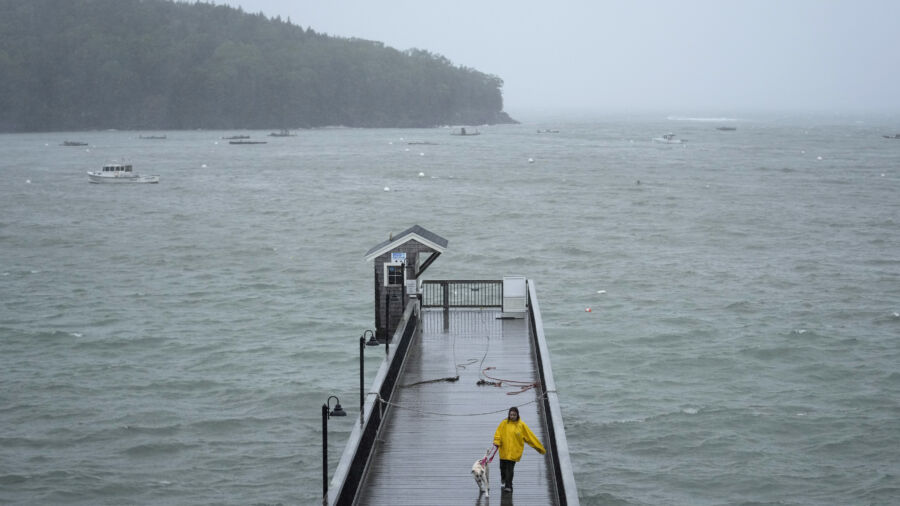BAR HARBOR, Maine—Atlantic storm Lee pummeled a large swath of New England and Maritime Canada with destructive winds, rough surf and torrential rains that toppled trees, flooded roadways and cut power to tens of thousands on Saturday. One person was killed in Maine when a tree limb fell on his vehicle.
The center of the sprawling post-tropical cyclone made landfall about 135 miles (215 kilometers) west of Halifax, the capital of Nova Scotia, according to the U.S. National Hurricane Center. That’s about 50 miles (80 kilometers) southeast of Eastport, Maine. It had near-hurricane-strength winds of 70 mph (110 kph), though the storm was weakening as it headed north to New Brunswick and the Gulf of St. Lawrence.
Lee flooded coastal roads in Nova Scotia and took ferries out of service as it fanned anxiety in a region still reeling from wildfires and severe flooding this summer. The province’s largest airport, Halifax Stanfield International, cancelled all flights.
“People are exhausted. … It’s so much in such a small time period,” said Pam Lovelace, a councilor in Halifax.
The storm was so big that it caused power outages several hundred miles from its center. At midday Saturday, 11 percent of electricity customers in Maine lacked power, along with 27 percent of Nova Scotia, 8 percent of New Brunswick, and 3 percent of Prince Edward Island.
Hurricane-force winds extended as far as 140 miles (220 kilometers) from Lee’s center, with tropical storm-force winds extending as far as 320 miles (515 kilometers)—enough to cover all of Maine and much of Maritime Canada.
In the United States, a tropical storm warning remained in effect from Stonington, Maine, north to the U.S.–Canada border.
That included Bar Harbor, the touristy gateway to Acadia National Park, where a whale watch vessel broke free of its mooring and crashed ashore. Authorities worked to offload 1,800 gallons of diesel fuel to prevent it from spilling into the ocean.
A 51-year-old motorist in Searsport, Maine, died after a large tree limb fell on his vehicle Saturday on U.S. Highway 1 during a period of high winds, the first fatality attributed to the storm.
The tree limb brought down live power lines, and utility workers had to cut power before the man could be removed, said Police Chief Brian Lunt. The unidentified man died later at a hospital, Lunt said.
Storm surge of up to 3 feet (0.91 meters) was expected along coastal areas, accompanied by large and destructive waves, the hurricane center said.
The storm skirted some of the most waterlogged areas of Massachusetts that experienced severe flash flooding days earlier, when fast water washed out roads, caused sinkholes, damaged homes and flooded vehicles.
In eastern Maine, winds died down enough by late afternoon for utility workers to begin using their bucket trucks to make repairs. Both Central Maine Power and Versant Power had hundreds of workers, including out-of-state crews, to assist in the effort.
“At this point, the storm is resembling a nor’easter,” said Sarah Thunberg, a National Weather Service meteorologist, referring to the fall and winter storms that often plague the region and are so named because their winds blow from the northeast. They typically have a much wider wind field than tropical systems, whose winds stay closer to a storm’s center.
But the entire region has experienced an especially wet summer—it ranked second in the number of rainy days in Portland, Maine—and Lee’s high winds toppled trees stressed by the rain-soaked ground in Maine, the nation’s most heavily wooded state.
Cruise ships found refuge at berths in Portland, while lobstermen in Bar Harbor and elsewhere pulled traps from the water and hauled boats inland.
Billy Bob Faulkingham, House Republican leader of the Maine Legislature, and another lobsterman survived after their boat overturned while hauling traps ahead of the storm Friday, officials said.
The boat’s emergency locator beacon alerted authorities, and the two clung to the hull until help arrived, said Winter Harbor Police Chief Danny Mitchell. The 42-foot boat sank.
“They’re very lucky to be alive,” Mr. Mitchell said.
Forecasters urged residents to stay home, but many ventured out anyway.
Betsy Follansbee and her husband, Fred, jogged to Higgins Beach in Scarborough, Maine, to watch surfers—some wearing helmets—paddling out to catch waves reaching 12 feet (3.6 meters). They were the biggest waves Ms. Follansbee has seen in her 10 years living there, she said.
“We’re impressed that they’re bold enough to try,” Ms. Follansbee said.
On Maine’s Bailey Island, a slender spit jutting into the Gulf of Maine, Ren Renton watched the ocean roil. “It comes and goes and takes what it wants, but hopefully not too much,” she said.
Lee shared some characteristics with 2012’s Superstorm Sandy. Both were once-strong hurricanes that became post-tropical cyclones—cyclonic storms that have lost most of their tropical characteristics—before landfall. Lee was not expected to be nearly as destructive as Sandy, which caused billions of dollars in damage and was blamed for dozens of deaths in New York and New Jersey.
Lee also isn’t anywhere near as severe as the remnants of Hurricane Fiona, which a year ago washed houses into the ocean in eastern Canada, knocked out power to most of two provinces and swept a woman into the sea, said Canadian meteorologist Jill Maepea.
Destructive hurricanes are relatively rare so far north. The Great New England Hurricane of 1938 brought gusts as high as 186 mph (300 kph) and sustained winds of 121 mph (195 kph) at Massachusetts’ Blue Hill Observatory. But there have been no storms that powerful in recent years.
By Robert F. Bukaty and David Sharp


